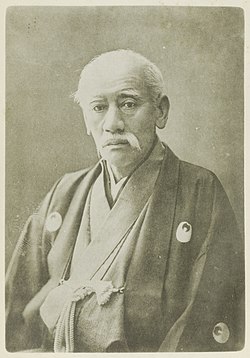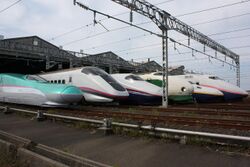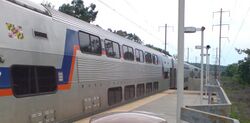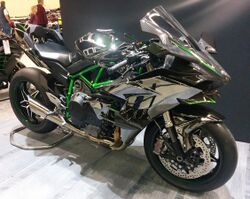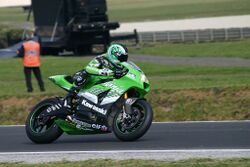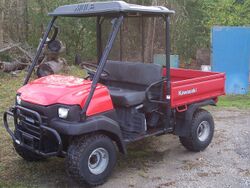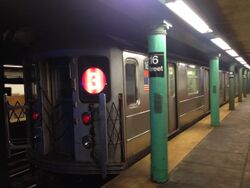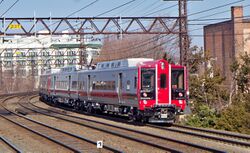Kawasaki Heavy Industries
Topic: Company
 From HandWiki - Reading time: 9 min
From HandWiki - Reading time: 9 min
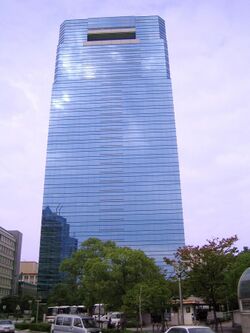 Kobe Crystal Tower, Kawasaki Heavy Industries' headquarters in Kobe | |
Native name | 川崎重工業株式会社 |
|---|---|
Romanized name | Kawasaki Jūkōgyō Kabushiki-gaisha |
| Type | Public KK |
| TYO: 7012 | |
| Industry | Heavy equipment Automotive industry Defense |
| Founded | 15 October 1896 |
| Founder | Shōzō Kawasaki |
| Headquarters | Chūō, Kobe, Japan Minato, Tokyo, Japan |
Key people | Yoshinori Kanehana (Chairman) Yasuhiko Hashimoto (president & CEO) |
| Products | Rolling stock, aerospace, shipbuilding, construction, automobiles |
| Brands | Kips (K) OTR.ind.2016 Kawasaki motor corps |
| Revenue | |
| Total assets | |
| Total equity | |
Number of employees | 34,010 (as of 31 March 2013) |
| Subsidiaries |
|
| Website | www global |
History
Shōzō Kawasaki, born in 1836, was involved with the marine industry from a young age. He was involved with two offshore disasters but accredited his survival to the modernization of the ships. This led to the decision to create technological innovations for the Japanese shipping industry. In 1878, after struggling to find business, his first order was placed. This is marked as the company's start in the industry.
In 1886, Kawasaki moved the business from Tokyo to Hyogo. This allowed space for the rise of orders placed to his company and the renaming to Kawasaki Dockyard. The new and improved company went public as Kawasaki Dockyard Co., Ltd when the demand for ships rose during the Sino-Japanese War of 1894. Kojiro Matsukata was announced as the company's first president.
After opening a new factory in 1906, Kawasaki began diversifying its products. They began to produce parts for the railroad, automotive, and airplane industry by the end of World War 1. After the war, along with the Allied arms-limitation agreement in 1912, Kawasaki faced a huge decline in shipbuilding. In 1929, the Depression caused a large amount of financial problems with the company.
During World War 2, Kawasaki was a major builder of combat aircraft like the Ki-61, which killed many US aircrew. Just afterwards, they adapted air intakes from combat aircraft to high speed motorcycles.[2][unreliable source?] In 1947, the government introduced a new shipbuilding agenda and gave Kawasaki a rise in profits and helped restore the company. The company was able to resume all operations and by the 1950s, Japan was leading as the world's largest shipbuilder.
By the late 1960s into the 1970s Kawasaki had begun to withdraw from the shipbuilding industry and diversified its company, producing motorcycles, jet skis, bridges, tunnel-boring machines, and aircraft. They also supplied technologically advanced railroad cars to the New York subway system.
In 1995, Kawasaki Heavy Industries came to an agreement with China to produce the largest containerships ever. This led to the company announcing higher than expected profits in 1996. However, shortly after the profits, the company saw a long decline in business forcing them to find a solution.
With the company seeing continuous losses into the 21st century, it formed a joint venture with Ishikawajima-Harima Heavy Industries Co. However, by the end of 2001, the agreement was terminated. In the following years, Kawasaki Heavy Industries Co. have seen a fluctuation of profits and losses.[3]
Products
Aerospace
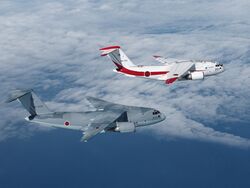

Kawasaki is active in a diverse range of the aerospace industry. The company is a contractor for the Japanese Ministry of Defense and has built aircraft such as the C-1 transport aircraft, T-4 intermediate jet trainer, and the P-3C antisubmarine warfare patrol airplane. Since 2007, it has built the P-1 maritime patrol aircraft, and since 2010, it has built the C-2 transport aircraft. Kawasaki also builds helicopters, including the BK117, jointly developed and manufactured with MBB. It also produces the CH-47J / JA helicopter.[4]
In the commercial aviation business, the company is involved in the joint international development and production of large passenger aircraft. It is involved in joint development and production of the Boeing 767, Boeing 777 and Boeing 787 with The Boeing Company,[5] and the 170, 175, 190 and 195 jets with Empresa Brasileira de Aeronáutica. It is also involved in the joint international development and production of turbofan engines for passenger aircraft such as the V2500, the RB211/Trent, the PW4000 and the CF34.
Kawasaki also works for the Japan Aerospace Exploration Agency. The company was responsible for the development and production of the payload fairings, payload attach fittings (PAF) and the construction of the launch complex for the H-II rocket. It continues to provide services for the H-IIA rocket.
Kawasaki has also participated in projects such as the development of reusable launch vehicles for spacecraft that will handle future space transport, space robotics projects such as the Japanese Experiment Module for the International Space Station, the cancelled HOPE-X experimental orbiting plane and the docking mechanism for the ETS-VII. According to a document from July 1997, they would have been a major manufacturer of the Kankoh-maru space tourism vehicle (also known as the Kawasaki S-1), which never saw production.[6]
Main products
- Aircraft
- Space systems
- Helicopters
- Simulators
- Jet engines
- Missiles
- Electronic equipment
Rolling stock
Kawasaki is Japan's largest manufacturer of rolling stock. It began operations in the industry in 1906. It manufactures express and commuter trains, subway cars, freight trains, locomotives, monorails and new transit systems. Kawasaki is also involved in the development and design of high-speed trains such as Japan's Shinkansen.
Main Products
- Electric cars (including Shinkansen trains)
- Monorails
- Passenger coaches and freight cars
- Diesel locomotives
- Electric locomotives
- Platform screen door systems
- Passenger coaches and freight cars integrated transit systems
Shipbuilding
Shipbuilding is the historical industry in which Kawasaki Heavy Industries was created and developed, as from the company's 1878 founding as the Kawasaki Dockyard Co.
Kawasaki Shipbuilding Corporation is a wholly owned subsidiary of Kawasaki Heavy Industries. Its product range include high-performance LNG and LPG carriers, container ships, bulk carriers and VLCCs, as well as submarines. The company is also involved in the development of offshore structures and research vessels.
Kawasaki also produces marine machinery and equipment, including main engines, propulsion systems, steering gears, deck and fishing machinery.
Kawasaki has shipyards at Kobe and Sakaide, Kagawa. (Kagawa Prefecture). The company also builds ships as a part of joint ventures with COSCO in China, i.e. the Nantong COSCO KHI Ship Engineering Co., Ltd.(NACKS), in Nantong, China, and the Dalian COSCO KHI Ship Engineering Co., Ltd.(DACKS), in Dalian, China.
Main products
- LNG carriers
- LPG carriers
- Container ships
- High speed vessels
- Submarines
- VLCCs (very large crude carriers)
- Bulk carriers
- Offshore structures
- Marine machinery and equipment
Energy plants and facilities
Kawasaki's key offering are high-performance gas turbines. The company is also involved in development of new energy sources as an alternative to fossil fuels such as wind power generation, biomass power generation, photovoltaic systems and rechargeable batteries.
Main products
- Small and medium-sized gas turbine generators
- Gas turbine cogeneration systems
- Gas engines
- Diesel engines
- Wind turbine generators
- Ash handling systems
- Combined cycle power plants
- Nuclear power plant equipment
- Boilers
Industrial equipment
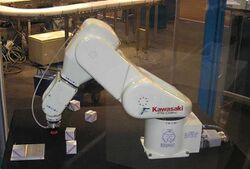
Kawasaki develops and builds a vast array of industrial plants and equipment, including large cement, chemical and nonferrous metal plants, prime movers, and compact precision machinery. It also offers industrial plant engineering from design to sales.
Kawasaki also develops automation systems. Industrial robots for processes such as assembly, handling, welding, painting and sealing, as well as automation systems for distribution and logistics such as automated product- and cargo-handling systems for plants and airports.
Main products
- Industrial plants
- Industrial robots
- Aerodynamic machinery
- Hydraulic equipment
Environment and recycling
Kawasaki is involved in the development of equipment that prevents pollution in a wide range of industries. Among the leading products are fuel gas desulfurization and denitrification systems, and ash handling systems. The company also supplies municipal refuse incineration plants, gasification and melting systems, sewage treatment and sludge incineration plants.
Kawasaki has also been developing systems that enable a wide range of municipal and industrial waste to be recovered, recycled and put to new use. Such systems include refuse paper and plastic fuel production facilities that convert wastepaper/plastics into an easy-to-handle solid fuel, equipment that converts old tires into highway paving materials and tiles, and machinery that sorts glass bottles by size and color.
Main products
- Municipal refuse incineration plants
- Water treatment systems
- Industrial waste recycling equipment
- Flue-gas desulfurization equipment
Infrastructure
Kawasaki's history of building steel structures spans more than a century, with bridge-building among its first businesses. The company offers of storage management for LNG,
Kawasaki's portfolio also includes retractable roofs, floors and other giant structures, the Sapporo Dome's retractable surface is one example.
For construction, Kawasaki produces products such as wheel loaders, tunnel machines, rollers, snowplows and purpose-specific loaders. The tunnel boring machines used to excavate the Channel Tunnel and the 14.14 m diameter shield machines used in the Tokyo Bay Aqua-Line construction are two well-known examples.[citation needed]
Main products
- Wheel loaders
- Construction machinery
- Shield Machines
- Tunnel boring machines
- Steel bridges
- LNG and LPG tanks
- Airport and port-related products
- Snowplows
Transportation
Kawasaki produces motorcycles, Jet Skis, ATVs and cars. Kawasaki's motorcycle include the Ninja sport bikes, and cruisers, dual-purpose and motocross motorcycles, as well as utility vehicles, ATVs and general-purpose gasoline engines. Kawasaki's "Jet Ski" has become a genericized trademark for any type of personal watercraft.
Affiliates and subsidiaries
Japan
- Akashi Ship Model Basin Co., Ltd.
- Alna Yusoki-Yohin Co., Ltd.
- Benic Solution Corp.
- EarthTechnica Co., Ltd.
- Enetec Co., Ltd.
- Fukae Powtec Corp.
- JP Steel Plantech Co.
- Kawaju Akashi Service Co., Ltd.
- Kawasaki Engineering Co., Ltd.
- Kawasaki Oita Manufacturing Co., Ltd.
- Kawasaki Metal Industries, Ltd.
- Kawasaki Setsubi Kogyo Co., Ltd.
- Kawasaki Shipbuilding Corporation
- Kawasaki Plant Systems, Ltd.
- Kawasaki Precision Machinery Ltd.
- Kawasaki Machine Systems, Ltd.
- Kawasaki Motors Corporation Japan
- Kawasaki Hydromechanics Corp.
- Kawasaki Life Corporation
- Kawasaki Naval Engine Service, Ltd.
- Kawaju Akashi Engineering Co., Ltd.
- KEE Environmental Construction, Co. Ltd.
- KEE Environmental Service, Ltd.
- Kawaju Gifu Service Co., Ltd.
- Kawaju Gifu Engineering Co., Ltd.
- Kawasaki Prime Mover Engineering Co., Ltd.
- Kawasaki Construction Co., Ltd.
- Kawasaki Rolling Stock Technology Co., Ltd.
- Kawaju Shoji Co., Ltd.
- Kawaju Techno Service Corp.
- Kawaju Tokyo Service Corp.
- Kawaju Facilitech Co., Ltd.
- Kawasaki Thermal Engineering Co., Ltd.
- K Career Partners Corp.
- K-GES Co., Ltd.
- K-Tec Corp.
- KGM (Kawaju Gifu Manufacturing) Co., Ltd.
- Kawasaki Setsubi Kogyo Co., Ltd.
- Kawasaki Construction Machinery, Hokkaido Ltd.
- Kawaju Sakaide Service Co., Ltd.
- Kawaju Kobe Support Co., Ltd.
- Kawaju Marine Engineering Co., Ltd.
- KHI JPS Co., Ltd.
- Kawasaki Shipbuilding Inspection Co., Ltd.
- Kawasaki Gas Turbine Research Center Ltd.
- Nichijo Manufacturing Co., Ltd.
- NIPPI Corporation
- Sapporo Kawasaki Rolling Stock Engineering Co., Ltd.
- Technica Corp.
- Union Precision Die Co., Ltd.
International
East Asia
- Kawasaki Marine Machinery Co. Ltd. (Wuhan, Hubei, China)
- Kawasaki Heavy Industries Ship Engineering Co. Ltd. (Nantong, Jiangsu, China; COSCO)
- Kawasaki Heavy Industries Machinery Trading Co. Ltd. (Shanghai, China)
- Kawasaki Heavy Industries Technology Co. Ltd. (Dalian, Liaoning, China)
- Kawasaki Precision Machinery (China) Ltd.
- Kawasaki Robotics Co. Ltd. (Tianjin, China)
- Kawasaki Heavy Industries Ltd. (Hong Kong)
- Kawasaki Machine Systems Ltd. (South Korea)
Europe
- Kawasaki Precision Machinery (U.K.) Limited
- Kawasaki Robotics (U.K.) Ltd.
- Kawasaki Robotics G.m.b.H.
- Kawasaki Gas Turbine Europe GmbH
- Kawasaki Motors Europe N.V.
- Kawasaki Heavy Industries Europe Finance B.V.
- Kawasaki Heavy Industries (Europe) B.V.
- Italian Motorcycle Investment S.p.A.
North America
- Canadian Kawasaki Motors Inc.
- Kawasaki Construction Machinery Corp. of America
- Kawasaki Heavy Industries (U.S.A.), Inc.
- Kawasaki Motors Corp., U.S.A.
- Kawasaki Motors Manufacturing Corp., U.S.A.
- Kawasaki Precision Machinery (U.S.A.), Inc.
- Kawasaki Rail Car, Inc.
- Kawasaki Robotics (U.S.A.), Inc.
Oceania
- Kawasaki Motors Pty. Ltd.
South America
- Kawasaki do Brasil Indústria e Comércio Ltda.
- Kawasaki Machinery do Brasil Maq. Equip. Ltda.
- Kawasaki Motores do Brasil Ltda.
- Estaleiro Enseada do Paraguaçu S.A.
South Asia
- India Kawasaki Motors (India)
- Kawasaki Motors (Bangladesh)
Southeast Asia
- Kawasaki Gas Turbine Asia Sdn. Bhd. (Malaysia)
- Kawasaki Motors (Malaysia) Sdn. Bhd. (Malaysia)
- Kawasaki Heavy Industries Pte. Ltd. (Singapore)
- Kawasaki Motors Enterprise Co. Ltd. (Thailand)
- KDT (KHI Design & Technical Service, Inc. (Pasay, Philippines)
- Kawasaki Motors Philippines (Muntinlupa, Philippines)
- Kawasaki Motors (Indonesia)
References
- ↑ 1.0 1.1 1.2 1.3 1.4 "Kawasaki Heavy Industries Ltd. Full 2022 Full Year Consolidated Financial Report Ended March". 31 March 2022. https://global.kawasaki.com/en/corp/ir/library/pdf/sta_220510-1e.pdf. Retrieved 11 May 2022.
- ↑ "Nakajima Ki-84 Hayate Frank, Japan's Best?". https://www.youtube.com/watch?v=gRQvnCfEbNA.
- ↑ "History of Kawasaki Heavy Industries, Ltd. – FundingUniverse". http://www.fundinguniverse.com/company-histories/kawasaki-heavy-industries-ltd-history/.
- ↑ Parsons, Dan. "Boeing set to deliver 100th Japanese CH-47 fuselage", FlightGlobal, 2 December 2014. Accessed 12 January 2016.
- ↑ Kelly, Tim. "Giant Japanese oven gives Boeing room to ramp up 787 output", Reuters, 13 March 2013. Accessed 19 January 2016.
- ↑ Anderson, Erik (July 1997). "Kankoh-maru Flight Manual". Space Future. http://www.spacefuture.com/archive/kankoh_maru_flight_manual.shtml.
External links
Template:250cc/Moto2 World Constructors' Champions Template:125cc/Moto3 World Constructors' Champions
 |
 KSF
KSF